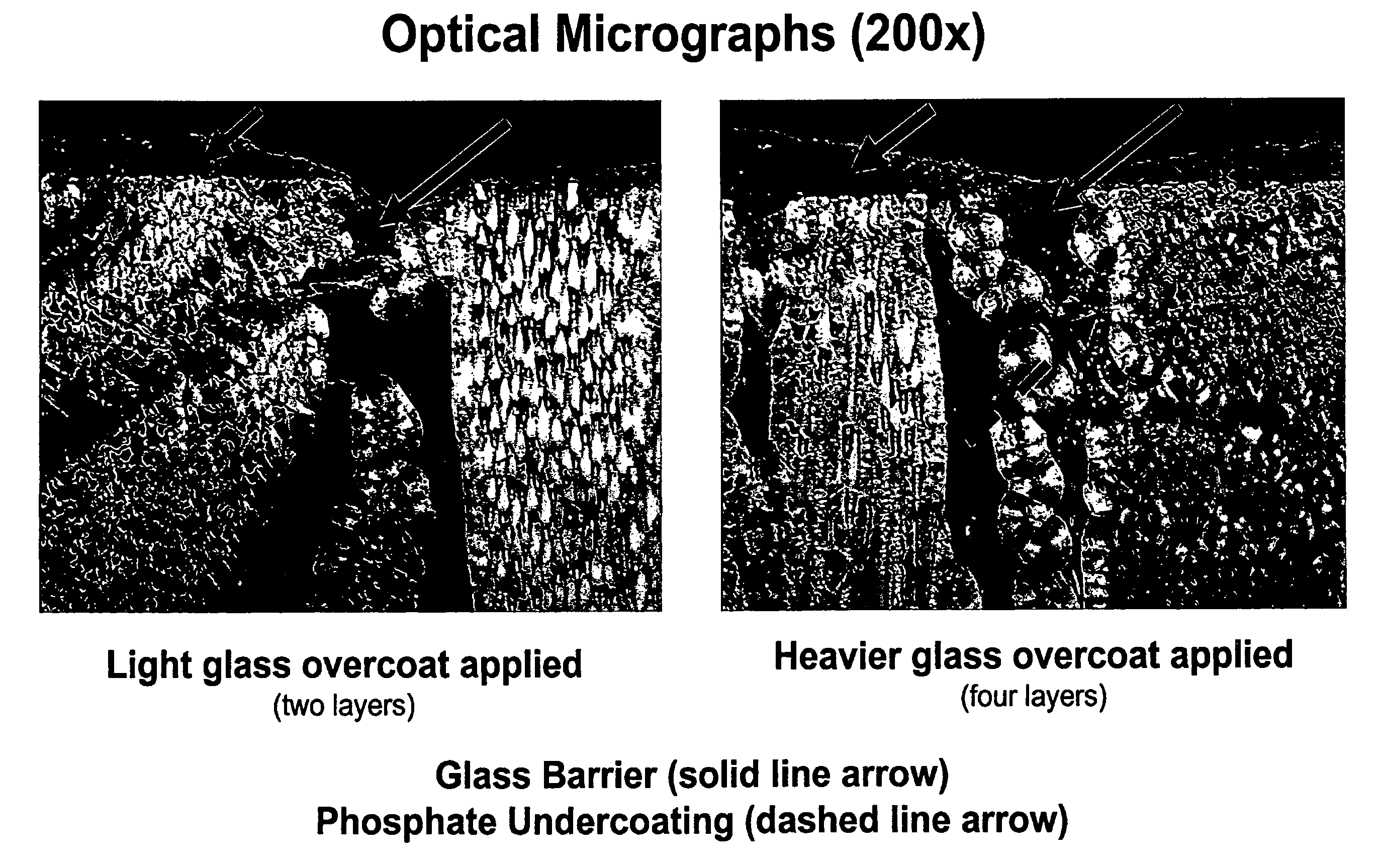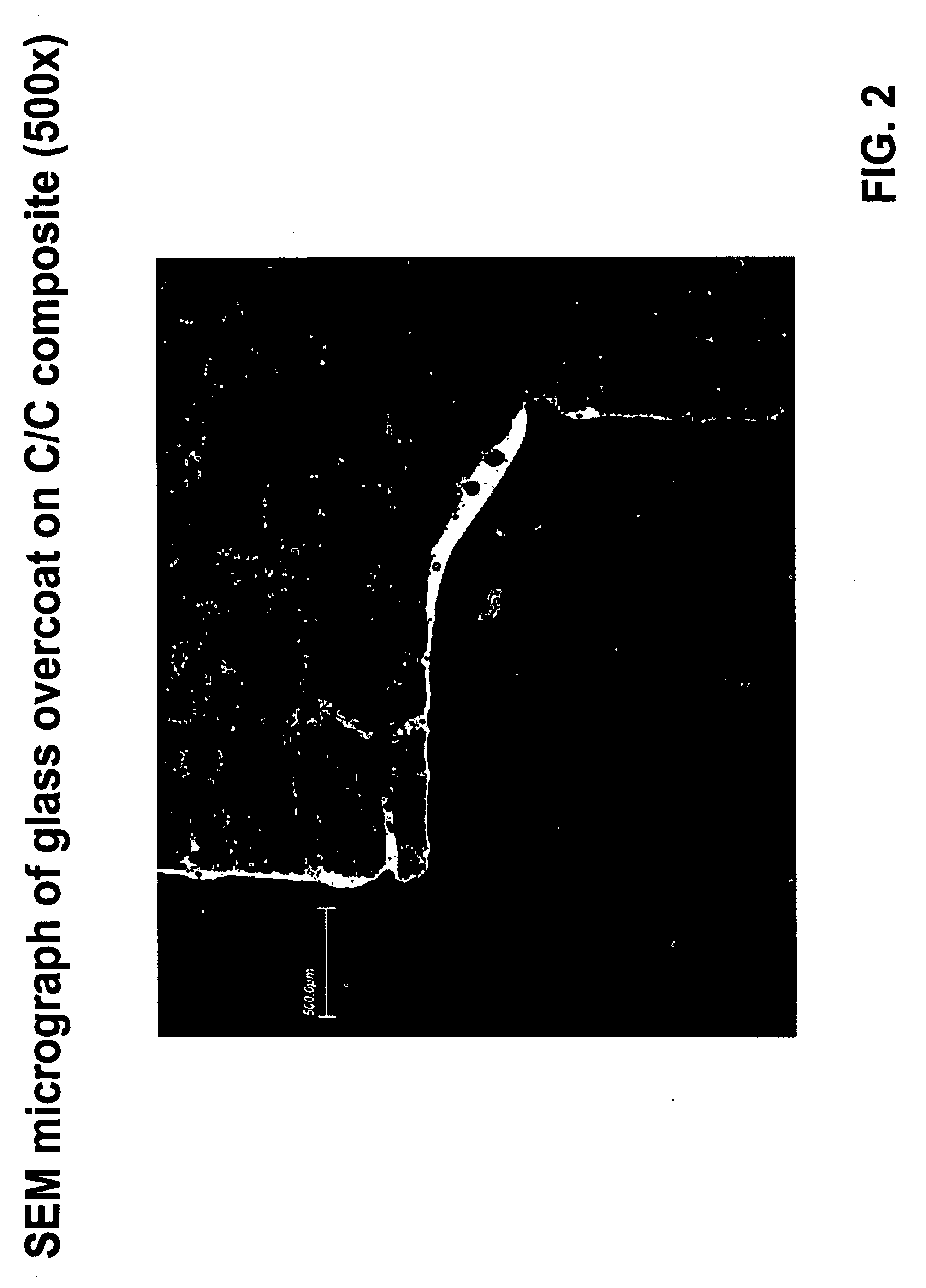Oxidation inhibition of carbon-carbon composites
a carbon-carbon composite and oxidation inhibition technology, applied in the direction of friction lining, transportation and packaging, mechanical equipment, etc., can solve the problems of reducing the oxidation efficiency of carbon-carbon composites
- Summary
- Abstract
- Description
- Claims
- Application Information
AI Technical Summary
Benefits of technology
Problems solved by technology
Method used
Image
Examples
examples 1-5
[0075]The following Examples 1-5 disclose phosphate glasses that can be used in the inventive oxidation inhibiting composition. These phosphate glasses may be prepared using the reactants shown in Table 1. In Table 1, all numerical values are in parts by weight.
TABLE 1IngredientEx. 1Ex. 2Ex. 3Ex. 4Ex. 5NH4H2PO490.40132.86148.94126.5388.83MgCO31.588.858.738.833.25BaCO3—20.725.1120.67—Li2(CO3)24.8415.5215.3117.424.17B(OH)33.216.446.366.433.16
[0076]The ammonium dihydrogen phosphate (NH4H2PO4), boric acid (B(OH)3), magnesium carbonate (MgCO3), barium carbonate (BaCO3) and lithium carbonate (Li2(CO3)2) are combined, blended and ground to form a dry powder. Example 1 is heated at 250° C. for 4 hrs and then at 750° C. for 5 hrs. Examples 2-4 are heated at 500° C. for 4 hrs. and then at 900° C. for 4 hrs. Example 5 is heated at 110° C. for 3 hrs, then at 230° C. for 18 hrs and then 715° C. for 1 hr. In one embodiment, the glass may be heated up to about 1300° C. or above to facilitate manuf...
example 6
[0077]A mixture of 100.00 parts by weight of NH4H2PO4, 4.26 parts by weight of B(OH)3, 5.87 parts by weight of MgCO3, 3.44 parts by weight of BaCO3 and 10.28 parts by weight of Li2CO3 is combined, blended and ground to form a dry powder. The mixture is fused stepwise with a final refinement stage at 900° C. for 4 hours. The resulting borophosphate glass is quenched and ground into a fine powder.
example 7
[0078]A mixture of 100.00 parts by weight of NH4H2PO4, 6.17 parts by weight of B(OH)3, 7.85 parts by weight of MgCO3, 5.21 parts by weight of BaCO3, 7.36 parts by weight of Al(P03)3 and 11.41 parts by weight of Li2CO3 is combined, blended and ground to form a dry powder. The mixture is fused stepwise with a final refinement stage at 900° C. for 4 hours. The resulting borophosphate glass is quenched and ground into a fine powder. Compounds that yield the equivalent oxide content of the carbonate and / or phosphate precursors indicated above may be substituted therefor.
[0079]The following Table 2 discloses oxidation inhibiting compositions that may be used with the inventive method:
TABLE 2IngredientComposition Ranges (wt. %)WaterAbout 30-60, or about 35-50,or about 42-45MALP (MonoaluminumAbout 2-25, or about 5-20, orPhosphate - 50% aqueous solution)about 10-14Ammonium DihydrogenAbout 0.5-10, or about 1-8, or aboutPhosphate2-4Phosphate Glass PowderAbout 15-55, or about 20-45, orabout 32-...
PUM
| Property | Measurement | Unit |
|---|---|---|
| mean particle size | aaaaa | aaaaa |
| mean particle size | aaaaa | aaaaa |
| depths | aaaaa | aaaaa |
Abstract
Description
Claims
Application Information
 Login to View More
Login to View More - R&D
- Intellectual Property
- Life Sciences
- Materials
- Tech Scout
- Unparalleled Data Quality
- Higher Quality Content
- 60% Fewer Hallucinations
Browse by: Latest US Patents, China's latest patents, Technical Efficacy Thesaurus, Application Domain, Technology Topic, Popular Technical Reports.
© 2025 PatSnap. All rights reserved.Legal|Privacy policy|Modern Slavery Act Transparency Statement|Sitemap|About US| Contact US: help@patsnap.com



